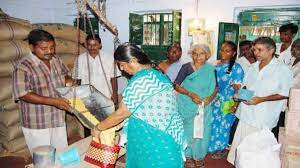Q. What are the major challenges of Public Distribution System (PDS) in India ? How can it be made effective and transparent ?
Ans: The Public Distribution System (PDS) in India is a government-sponsored food distribution program aimed at providing essential commodities like rice, wheat, and sugar to vulnerable and low-income sections of the population at subsidized rates. While the PDS has played a significant role in addressing food security and poverty alleviation, it faces several challenges that hinder its effectiveness and transparency.

Challenges of the PDS in India
- Leakages and Diversion: One of the most significant challenges is leakages in the system, where subsidized food intended for the needy ends up being diverted to the open market or siphoned off by corrupt officials, resulting in food not reaching the intended beneficiaries.
- Identification of Beneficiaries: Proper identification and targeting of beneficiaries remain a challenge. There is often incomplete or inaccurate data on eligible beneficiaries, leading to inclusion and exclusion errors.
- Quality of Food Grains: The quality of food grains distributed through the PDS can sometimes be subpar, affecting the nutritional value and consumption of the subsidized food.
- Supply Chain and Storage Issues: Inadequate storage facilities, transportation bottlenecks, and poor infrastructure can lead to spoilage of food grains and delays in distribution.
- Bureaucratic Red Tape: Cumbersome administrative processes, delays in issuing ration cards, and complex procedures can hinder efficient delivery of food to beneficiaries.
- Corruption and Middlemen: The presence of intermediaries and corrupt practices can result in beneficiaries receiving less than their entitled quota, undermining the purpose of the program.
- Lack of Awareness: Many eligible beneficiaries are unaware of their rights and entitlements under the PDS, which can lead to reduced participation and access to subsidized food.
To make the PDS more effective and transparent, several measures can be taken:
- Digitization and Aadhaar Integration: Linking PDS beneficiaries’ information with the Aadhaar system and using technology for tracking and distribution can help reduce leakages and enhance transparency.
- Biometric Authentication: Implementing biometric authentication during distribution can help ensure that only eligible beneficiaries receive the subsidized food.
- Regular Audits and Monitoring: Establishing robust monitoring mechanisms, including third-party audits, can help identify leakages, diversions, and inefficiencies in the system.
- Community Participation: Involving local communities, civil society organizations, and beneficiary groups in monitoring and oversight can help curb corruption and ensure proper distribution.
- Improved Grievance Redressal: Setting up effective grievance redressal mechanisms and toll-free helplines can enable beneficiaries to report issues and seek resolutions.
- Decentralized Procurement: Encouraging decentralized procurement of food grains can help reduce delays and improve supply chain efficiency.
- Strengthening Public Awareness: Conducting awareness campaigns to educate beneficiaries about their entitlements, procedures, and rights under the PDS can improve participation and utilization.
- Direct Benefit Transfer (DBT): Exploring the possibility of providing cash transfers directly to beneficiaries’ bank accounts can eliminate intermediaries and increase transparency.
- Social Audits: Conducting regular social audits involving beneficiaries and local communities can help ensure that the PDS is functioning effectively and reaching its intended beneficiaries.
Addressing these challenges and implementing these measures can help enhance the effectiveness and transparency of the Public Distribution System in India, ensuring that subsidized food reaches those who need it the most.
Thanks for reading the answer to the question: What are the major challenges of Public Distribution System (PDS) in India ?
Read: